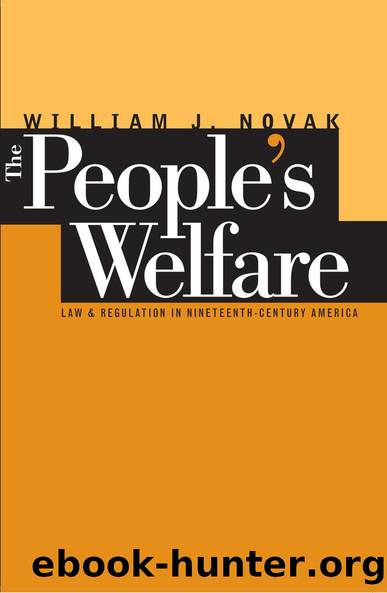The People's Welfare by William J. Novak

Author:William J. Novak [Novak, William J.]
Language: eng
Format: epub
Tags: History, United States, 19th Century, Law, Legal History
ISBN: 9780807863657
Google: 0vJECQAAQBAJ
Publisher: Univ of North Carolina Press
Published: 2000-11-09T02:56:46+00:00
The Road to Slaughterhouse
As late as 1872 then, the common law vision of a well-regulated society still dominated public health police. Trades, businesses, and industrial occupations deemed hazardous to the health and welfare of the community were held subject to the dictates of salus populi159 and sic utere tuo. But public health law in the 1860s and 1870s also augured some important changesâchanges in governance and law, changes in public power and private right. In the Manhattan Fertilizing Companyâs objections to summary abatement, we see the emergence of new ideas about constitutional rights as substantive limits on health police. Simultaneously, states and municipalities pioneered ever more powerful and centralized public controls in their attempts to guarantee public health. Liberty and authority, once fused in the notion of organic, self-regulating communities in which all were bound by customary rules of their own choosing, were slowly disentangling themselves. Eventually and reluctantly, they would reconverge in the liberal notion of a positivist state limited by absolute constitutional rights.
On the public powers side of the equation, the 1860s and 1870s witnessed a shift in the locus of prosecution of offensive trades from private individuals and diverse local officials to centralized boards of health with plenary power over public nuisances. In 1866, New York created the Metropolitan Sanitary District to consolidate the public health concerns of New York City and Brooklyn and place them under the direction of a single state agency. The Metropolitan Board of Health was given complete authority to control health hazards in the two cities. Almost immediately upon passage, the board began an unprecedented, coordinated attack on public nuisances in New York. Within two years, twelve cases involving the boardâs actions reached the New York appellate courts.160
The New York courts overwhelmingly upheld the boardâs legislatively granted powers. In Coe v. Schultz (1866), the owners of a poudrette manufactory at Hunterâs Point challenged the boardâs order to discontinue their operations until altered so that odors and fumes could not escape into the air.161 The plaintiff claimed that the execution of such an order without a trial and without a jury deprived him of his property âwithout due process of law.â Justice Sutherland held such a contention âutterly without any colorable support,â basing his decision on the long-held power of citizens to abate public nuisances at common law.162 In Metropolitan Board of Health v. Heister (1868), the court approved the boardâs power to pass ordinances outlawing slaughterhouses and to close down violating establishments.163 Chief Justice Hunt argued that such powers had long histories: â[F]rom the earliest organization of the government, the absolute control over persons and property, so far as the public health was concerned, was vested in boards or officers, who exercised a summary jurisdiction over the subject, and who were not bound to wait the slow course of the law.â Almost every year, the legislature chartered some city or village with local powers to summarily remove noxious trades.164
But try as they might, New York judges had to be aware that something was new in these cases besides the due process arguments of plaintiffs.
Download
This site does not store any files on its server. We only index and link to content provided by other sites. Please contact the content providers to delete copyright contents if any and email us, we'll remove relevant links or contents immediately.
2010-The City & the City by China Miéville(1917)
Anatomy of Injustice by Raymond Bonner(1560)
ADHD on Trial by Michael Gordon(1505)
That Every Man Be Armed by Stephen P. Halbrook(1501)
Injustices by Ian Millhiser(1429)
You Don't Own Me by Orly Lobel(1385)
Tell by Major Margaret Witt(1336)
Course Correction by Ginny Gilder(1328)
A Vast Conspiracy by Jeffrey Toobin(1273)
Broken Scales by Joel Cohen(1262)
First by Evan Thomas(1226)
Without Copyrights by Spoo Robert(1212)
J by Howard Jacobson(1201)
A Religious Orgy in Tennessee by H.L. Mencken(1177)
The Run of His Life: The People v. O. J. Simpson by Jeffrey Toobin(1163)
A Triumph of Genius: Edwin Land, Polaroid, and the Kodak Patent War by Ronald K. Fierstein(1146)
A History Of Thailand by Baker Chris(1120)
John Wayne Gacy by Judge Sam Amirante(1055)
Law 101: Everything You Need to Know About American Law, Fourth Edition by Jay Feinman(1048)
